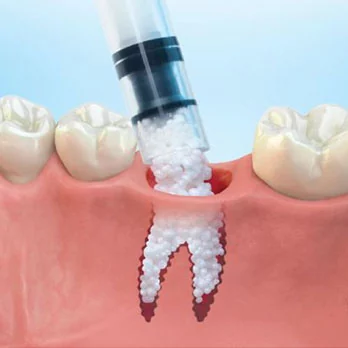
Sometimes, you get your tooth extracted for some compelling reason. Now if there is no implant added to that place right away, the jaw bone may shrink resulting in a significant loss of bone because of its reabsorption. In future, if you plan to have an implant over that missing tooth, it may fail because the bone mass of the jaw is reduced. To overcome this situation, you may need some bone mass over that place. Bone augmentation will help you out in this case. It will help you restore the density and volume of your jaw bone.
What is bone augmentation?
Bone augmentation is a surgical procedure wherein the doctor will replace the missing bone with grafting material which will allow regeneration of new bone. Generally, the graft material gets reabsorbed as the natural bone regrows. This allows new implants to hold on to your jaw bone.
Who qualifies for bone augmentation?
There can be a significant loss of bone due to aging, some developmental defects, periodontal disease or simply a missing tooth. Now if you have experienced such a bone loss, then you may need a bone graft to support the existing teeth or for a restoration.
You can consult your dental doctor or visit a dental clinic in Hyderabad. Or you can request an appointment at Apollo Dental, Hyderabad by calling 18001020288.
Why is bone augmentation conducted?
By constant motion and pressure chewing your jaw bone usually maintains its health. Now if a tooth is missing and left unreplaced, your jaw bone tends to break down. To avoid this bone loss, a dental implant or a bone augmentation is advised.
How is bone augmentation conducted?
You need to consult a periodontist or a dental surgeon for a treatment plan. Your bone augmentation procedure will depend on the purpose of your treatment, but you can expect the following steps:
- Anesthesia: your oral surgeon will use local anesthesia to numb the site on which the procedure will be done.
- Tooth extraction and/or bone sourcing: if your tooth needs to be removed, then your dentist may perform extraction at this point and if not, then he/she will start by sourcing the bone, if needed.
- Graft insertion: your periodontist will clean the area if a tooth is extracted and if not, then he or she will make an incision on the site where the graft needs to be inserted. After that, he/she will attach the graft material to the exposed bone.
- Stitching: after inserting the graft, the exposed area will now be closed by stitching so that the tissue holds together and helps in healing.
- Recovery: you can go back home the same day of the procedure, although it takes 4-6 months to completely heal and be ready for your dental implant.
Different types of bone augmentation:
- Guided bone regeneration
- Ridge spitting
- Distraction osteogenesis
- Maxillary sinus augmentation
- Autogenous block bone grafting
What are the benefits?
Restoration of bone mass and structure by bone grafting will help you avoid other types of dental problems and a dental implant can transform your smile.
What are the complications?
Sometimes infections may develop around the area of the implant and if left untreated, it may lead to tissue damage.
To conclude, if you lose one or more teeth through injury, trauma, or any gum disease, bone augmentation may be used to restore the bone mass and help you transform your smile. You should always consult a periodontist when such a situation arises.
Well, you should not brush the area of dental grafting for at least 24 hours. However, when you start brushing, be very gentle or you may use an antibiotic rinse twice a day.
You can have milkshakes, curd, puddings, and so on. You should avoid crunchy food items like popcorn and chips.
After surgery, you should avoid touching the area of grafting and also should not do vigorous mouth rinsing.














































